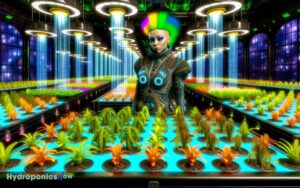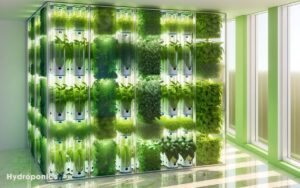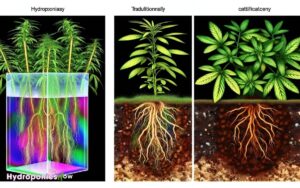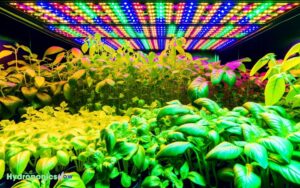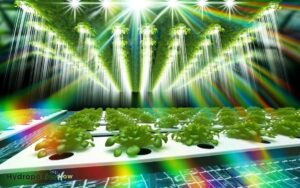Safely Eat Hydroponic Plants: A Guide to Yes
Yes, hydroponic plants are safe to eat. This cultivation method uses nutrient-rich water solutions in place of soil, which minimizes risks of soil-borne diseases and pests.
Proper nutrient management guarantees these plants retain essential nutrients, benefiting health. Controlled environments reduce the need for chemical pesticides, resulting in lower residue levels.
Regular testing and filtration maintain water quality and prevent contaminants. Additionally, hydroponic plants can boast higher levels of certain vitamins and minerals due to precise nutrient application.
For further insights into the nuanced safety aspects and nutritional benefits, a more in-depth exploration will be invaluable.
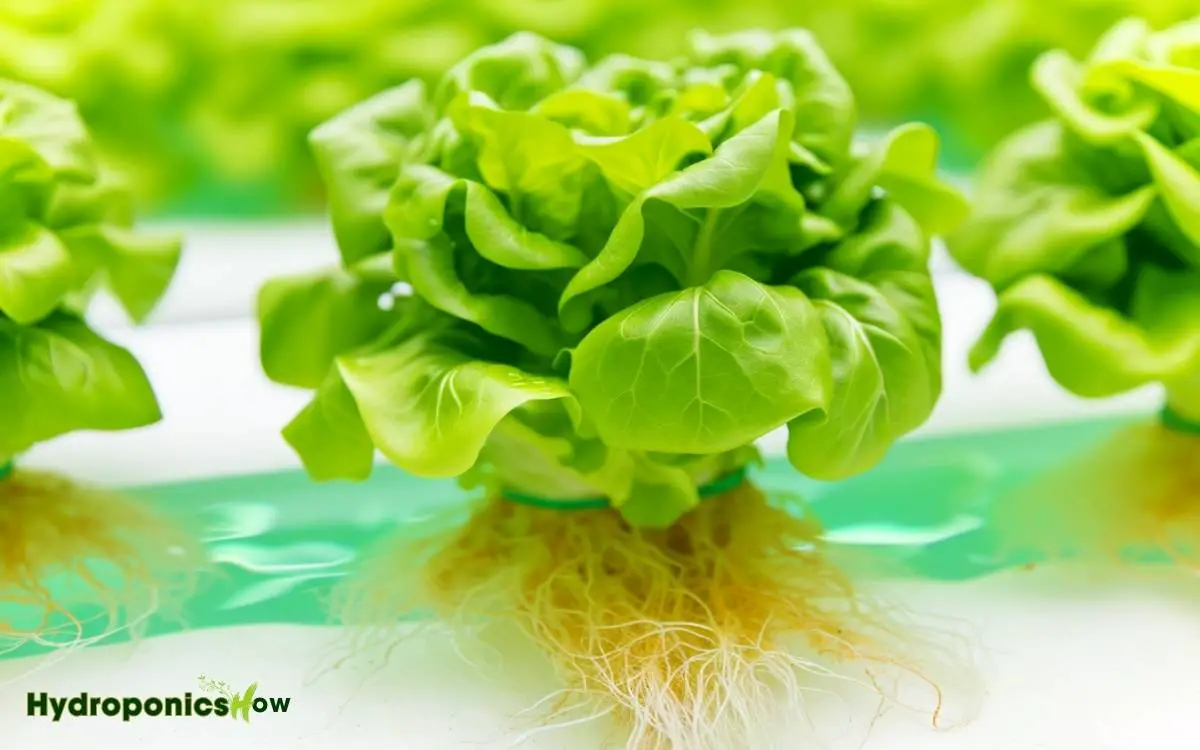
Key Takeaways
Understanding Hydroponics
How does hydroponics, a method of growing plants without soil, fundamentally alter the traditional paradigms of agriculture?
Hydroponics, by substituting soil with nutrient-rich water solutions, enables precise control over plant growth conditions. This method mitigates the risks associated with soil-borne diseases and pests, reducing the need for chemical pesticides.
Hydroponic systems optimize water usage, often requiring substantially less water than conventional farming, addressing critical concerns of water scarcity.
Moreover, hydroponics facilitates year-round cultivation and can be implemented in urban settings, reducing the distance between production and consumption.
This innovative approach not only enhances crop yield and quality but also provides sustainable solutions adaptable to various environmental constraints, revolutionizing modern agricultural practices.
Nutrient Quality
Nutrient quality in hydroponically grown plants is a crucial aspect of their overall safety and health benefits. Investigating the retention of essential nutrients and comparing the mineral content with soil-grown counterparts provides valuable insights into their nutritional profile.
This examination highlights the potential benefits and limitations inherent in hydroponic systems, offering a thorough understanding of their impact on plant nutrient composition.
Essential Nutrient Retention
The retention of essential nutrients in hydroponically grown plants is crucial for guaranteeing both their nutritional quality and overall health.
Hydroponic systems are designed to optimize nutrient delivery, which can impact the levels of vitamins, minerals, and other beneficial compounds in the produce.
Research indicates that nutrient retention in hydroponic plants is comparable to, and sometimes exceeds, that of soil-grown counterparts.
Key factors influencing nutrient retention include:
- Nutrient Solution Composition: Precise formulation of nutrient solutions guarantees plants receive balanced nutrition.
- Environmental Control: Regulated temperature, humidity, and light conditions enhance nutrient uptake.
- Plant Variety: Different plant species and cultivars have varying capacities for nutrient absorption.
Understanding these factors helps in maintaining high nutritional standards for hydroponically grown produce.
Mineral Content Comparison
Comparative studies between hydroponically and soil-grown plants reveal significant insights into the variations in mineral content and overall nutrient quality.
Research indicates that hydroponically grown plants can exhibit higher concentrations of certain minerals such as potassium, magnesium, and phosphorus due to the optimized and controlled nutrient solutions.
Conversely, soil-grown plants often have a more diverse mineral profile, influenced by soil composition and microbial interactions.
However, the nutrient uptake in hydroponics can be finely tuned to match or exceed that of traditional methods. The availability of essential micronutrients like zinc and iron is also comparable between the two systems.
Ultimately, the nutrient quality of hydroponically grown plants is contingent on precise nutrient management, ensuring they are equally, if not more, nutritious than their soil-grown counterparts.
Pesticide Use
In hydroponic systems, the controlled environment greatly reduces the necessity for chemical pesticides, resulting in minimal chemical exposure.
This approach not only enhances plant safety but also aligns with the principles of organic pest control, which employs biological agents and non-toxic methods to manage pests.
Consequently, hydroponically grown plants often exhibit lower pesticide residues compared to traditional soil-grown counterparts, promoting consumer health and ecological sustainability.
Minimal Chemical Exposure
Hydroponic systems greatly reduce the need for chemical pesticides by fostering a controlled and sterile growing environment.
This substantial reduction in chemical exposure offers several advantages for both consumer health and environmental sustainability.
Specifically:
- Reduced Chemical Residues: With minimal pesticide application, hydroponically grown plants often contain fewer chemical residues compared to traditional farming methods.
- Lower Risk of Contamination: The controlled environment mitigates the risk of soil-borne diseases and pests, which often necessitate heavy pesticide use in conventional agriculture.
- Enhanced Safety: Decreased reliance on chemical pesticides translates to safer consumption, reducing potential adverse health effects associated with pesticide exposure.
These factors collectively contribute to the growing perception of hydroponic produce as a safer, more sustainable option for consumers.
Organic Pest Control
In addition, hydroponic systems inherently reduce the need for chemical interventions, integrated organic pest control methods further bolster plant health and safety by utilizing natural predators and biopesticides.
These methods include the introduction of beneficial insects such as ladybugs, which prey on aphids, and the use of biopesticides like neem oil, derived from the neem tree, to combat a variety of pests.
These strategies are not only effective but also minimize the risk of chemical residues on plants, ensuring a safer consumption profile.
Moreover, microbial inoculants can enhance plant resistance to diseases, promoting overall robustness. By employing these organic practices, hydroponic growers can maintain a high standard of produce quality while adhering to eco-friendly and health-conscious principles.
Chemical Residues
Chemical residues in hydroponic systems can arise from the use of fertilizers, pesticides, and other nutrient solutions that may leave trace amounts on plants.
These substances, while essential for plant growth, might contribute to the accumulation of chemical residues on consumable parts of hydroponic plants. It is important to understand the potential impacts and management practices to mitigate these residues.
Key considerations include:
- Type of Chemicals Used: Selecting organic or bio-based fertilizers and pesticides can minimize harmful residues.
- Application Methods: Proper dosages and application techniques can reduce overuse and subsequent residue accumulation.
- Regulatory Compliance: Adhering to safety standards and regulations ensures that residue levels remain within acceptable limits, safeguarding consumer health.
Understanding these factors is crucial for evaluating the safety of hydroponically grown produce.
Water Quality
Ensuring the purity and safety of water used in hydroponic systems is vital, as it directly influences the overall health and contamination levels of the plants. Hydroponic systems rely heavily on water as the primary medium for delivering nutrients.
Hence, any contaminants present in the water, such as heavy metals, pathogens, or chemical residues, can be readily absorbed by the plants, posing potential health risks to consumers.
Regular water testing is essential to monitor and maintain peak quality. The use of reverse osmosis filters and UV sterilization can effectively eliminate impurities.
Additionally, maintaining pH levels between 5.5 and 6.5 ensures nutrient availability and uptake.
Strict adherence to water quality standards is essential for the safe cultivation of hydroponic plants.
Disease Risks
Disease risks in hydroponic systems primarily stem from fungal infections, bacterial contamination, and pest infestations, which can severely impact plant health and yield.
These risks are often exacerbated by the controlled environment that hydroponics necessitates, which can inadvertently create ideal conditions for pathogens.
Key disease risks include:
- Fungal Infections: Root rot caused by Pythium and Fusarium species can devastate hydroponic crops.
- Bacterial Contamination: Pathogens like Erwinia and Xanthomonas can infiltrate nutrient solutions, leading to systemic plant diseases.
- Pest Infestations: Aphids, spider mites, and whiteflies can transfer viruses and other microorganisms, further compromising plant health.
Mitigating these risks requires vigilant monitoring, sanitation practices, and integrated pest management strategies. Understanding these disease vectors is vital for maintaining the safety and productivity of hydroponic systems.
Contaminants in Systems
In hydroponic systems, various contaminants such as heavy metals, pesticides, and excess nutrients can accumulate in the water, posing significant risks to both plant health and human consumption.
Heavy metals like lead and cadmium can be introduced through contaminated water sources or substandard nutrient solutions. Pesticides, even in trace amounts, may persist and concentrate in closed hydroponic environments.
Moreover, over-fertilization can lead to an excess of nutrients such as nitrates and phosphates, which may be absorbed by the plants and subsequently ingested by consumers.
Regular monitoring and stringent quality control measures are essential to mitigate these risks. Adopting purified water sources and organic nutrient solutions can markedly reduce the likelihood of contamination, ensuring safer hydroponic produce.
Taste and Texture
While maintaining contaminant-free hydroponic systems is essential for safety, the taste and texture of hydroponically grown plants are equally influenced by the controlled environment and nutrient solutions utilized.
The precise regulation of these factors allows for optimization of sensory qualities.
Research indicates that hydroponic plants often exhibit consistent taste and texture due to:
- Nutrient Precision: Tailored nutrient solutions provide plants with exact amounts of necessary minerals, enhancing flavor profiles.
- Environmental Control: Stable temperature, humidity, and light conditions minimize stress, leading to more uniform texture.
- Rapid Growth: Accelerated growth in hydroponic systems can result in tender, crisp plant tissues.
These attributes contribute to the sensory appeal of hydroponically grown produce, underscoring the impact of cultivation methods on end product quality.
Nutritional Comparison
A comparative analysis of hydroponically grown plants and their soil-grown counterparts reveals significant differences in their nutritional profiles. This variation largely stems from differences in nutrient availability and absorption, as hydroponic systems provide a controlled environment with precisely measured nutrients. Understanding hydroponic plant food basics is essential for optimizing growth, as these plants rely entirely on nutrient solutions rather than soil-derived minerals. As a result, hydroponically grown plants often exhibit higher levels of certain vitamins and minerals, though their composition can vary based on the specific nutrient mix used.
Research indicates that hydroponic plants often exhibit higher levels of certain vitamins and minerals due to the controlled nutrient environment. However, soil-grown plants may benefit from a broader range of micronutrients available in natural soil.
The table below summarizes key nutritional differences:
| Nutrient | Hydroponic Plants | Soil-Grown Plants |
|---|---|---|
| Vitamin C | Higher | Lower |
| Iron | Higher | Lower |
| Magnesium | Lower | Higher |
| Antioxidants | Comparable | Comparable |
| Phytochemicals | Variable | Variable |
These variations underscore the importance of understanding how cultivation methods impact nutritional outcomes, informing consumer choices and dietary planning.
Organic Certification
Understanding the nutritional differences between hydroponically and soil-grown plants naturally leads to questions about organic certification and its implications for hydroponic produce.
Organic certification is governed by strict criteria, which traditionally emphasize soil health. However, hydroponic systems can still achieve organic status if they meet certain standards.
Key requirements include:
- Prohibited Substances: The use of synthetic pesticides and fertilizers is forbidden.
- Sustainability Practices: Systems must implement sustainable practices, such as water conservation.
- Non-GMO Seeds: Certified organic hydroponic produce must be grown from non-genetically modified seeds.
These criteria guarantee that hydroponic produce aligns with organic principles, maintaining a focus on environmental stewardship and consumer health, despite the absence of soil.
Environmental Impact
Evaluating the environmental impact of hydroponic systems shows significant advantages for resource efficiency and sustainability in comparison to traditional soil-based agriculture.
Hydroponic systems utilize up to 90% less water, as the closed-loop systems recycle water, drastically reducing consumption. Additionally, they minimize the need for chemical pesticides and herbicides, promoting healthier ecosystems.
The controlled environment of hydroponics also allows for higher crop yields on smaller footprints, effectively reducing land use and deforestation pressures.
Moreover, hydroponic farms can be established in urban areas, decreasing the carbon footprint associated with transportation.
These systems’ ability to operate year-round, irrespective of climate, further enhances their sustainability credentials, making hydroponics a promising solution for future agricultural practices.
Consumer Perception
While the environmental benefits of hydroponics are well-documented, consumer perception remains a critical factor in determining the widespread adoption and success of these systems.
Public acceptance hinges on various aspects:
- Health Concerns: Many consumers question whether hydroponically grown produce is as nutritious as soil-grown counterparts.
- Taste and Quality: There is a perception that hydroponic plants might lack the flavor and texture of traditionally grown produce.
- Chemical Usage: Concerns about the types and amounts of nutrients and pesticides used in hydroponic systems persist.
These factors influence purchasing decisions and market acceptance.
Scientific studies and transparent practices are essential in addressing these concerns, ensuring consumers are well-informed about the safety and benefits of hydroponic plants.
Conclusion
Hydroponic plants are generally safe to eat, with studies indicating that they can be as nutritious as soil-grown counterparts.
Importantly, hydroponic systems often use 90% less water, highlighting their environmental efficiency.
The absence of soil reduces pesticide use, although chemical residues from nutrient solutions require monitoring. Water quality remains important to plant health and safety.
While not always eligible for organic certification, hydroponically grown produce is increasingly accepted by health-conscious consumers.

